A symbol of hope
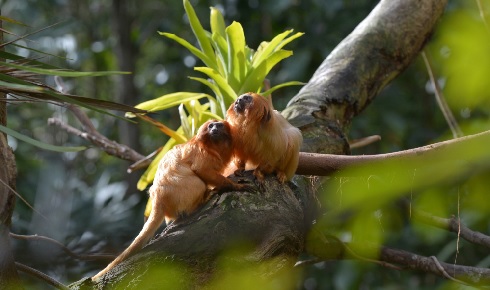
This year marks 50 years since the first efforts to protect Brazil’s golden lion tamarins began. It has become one of the region’s most innovative and inspiring conservation stories, writes Jeremy Mallinson OBE FRSB
December 4th 2020
The Atlantic Forest extends from the far north-east of Brazil south along the coast as far as north-east Argentina and into eastern Paraguay. Tropical and subtropical moist, montane and lowland forest, it is perhaps the most striking example of a biodiversity hotspot: very high biodiversity and endemism, but today largely decimated, with less than 8% of its original forest remaining and mostly in thousands of fragments and patches. It once covered 1.5 million square kilometres. Twenty-three primates are found there and all but three are found nowhere else. Among these are four species of lion tamarins (Leontopithecus), a genus of small monkeys endemic to the Atlantic Forest.
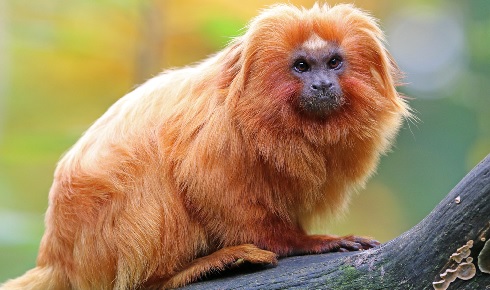 The golden lion tamarin (Leontopithecus rosalia) is one of the most threatened primates in Brazil
The golden lion tamarin (Leontopithecus rosalia) is one of the most threatened primates in BrazilThis year the 2nd August marked Golden Lion Tamarin Day in celebration of 50 years of the international conservation programme for what is one of Brazil’s most threatened species of primate. Portrayed on Brazil’s 20 Reais banknotes since 2002 and featured on a series of Brazilian postage stamps, the golden lion tamarin has become for Brazil what the giant panda is for China: an icon representing the need to preserve the treasures of the Atlantic Forest[1].
Lion tamarins belong to the family Callitrichidae, comprising in all 50 species of pygmy marmosets, Amazonian marmosets, a dwarf marmoset, Goeldi’s monkey and the tamarins of Amazonia. They are all small diurnal insectivores (also eating small lizards and frogs on occasion) and frugivores. They are the only monkeys that give birth to twins, and while formerly thought to be monogamous (unusual in primates), this is not always the case and they have been found to be polyandrous. This is associated with the finding that they are cooperative breeders, with group members – especially adult males and older siblings – helping to carry infants.
Lion tamarins have long hands and fingers that help them probe crevices, especially the tight spaces between the leaves of the large epiphytic tank bromeliads that harbour their preferred menu of insects, larvae, tadpoles and frogs[2].
A 50-year effort
In the early 1970s Dr Adelmar F Coimbra-Filho, the doyen of Brazilian primatologists, estimated that the population of the golden lion tamarin (Leontopithecus rosalia) had fallen to fewer than 200–300, restricted to forests in the state of Rio de Janeiro.
By 1974, after Coimbra-Filho alerted the Government and the international conservation community of the golden lion tamarin’s endangered status, his efforts resulted in the creation of the Poço das Antas Biological Reserve. The park, the first biological reserve in Brazil, was home to an important remnant population of the golden lion tamarin and the first milestone in conservation measures for the species that have continued to this day[3].
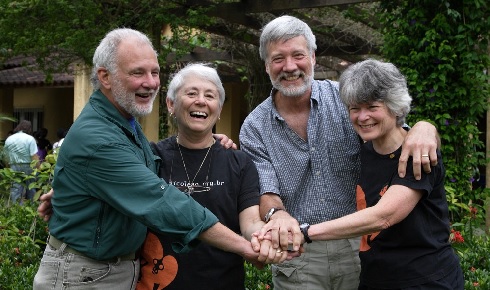 Core leaders of the Golden Lion Tamarin Conservation Programme: Dr Ben Becks, Dr Devra Kleiman, Dr James Dietz and Lou Ann Dietz
Core leaders of the Golden Lion Tamarin Conservation Programme: Dr Ben Becks, Dr Devra Kleiman, Dr James Dietz and Lou Ann Dietz
In the mid-1970s a series of conferences galvanised interest in the issue and the small, mismanaged captive population of golden lion tamarins. Devra Kleiman addressed this problem by creating a committee of all those organisations that had lion tamarins in their care while carrying out research on their physiology and behaviour. This led to the development of management and husbandry protocols, and a scientifically managed population, beneficial not just for their welfare, but for their reintroduction to the wild.
By the 1980s conservation efforts for the golden lion tamarin and the other two species known at the time – the golden-headed lion tamarin (L. chrysomelas) and the black lion tamarin (L. chrysopygus) – were also being guided by international committees, inspired by success of the captive breeding committee created for the golden lion tamarin[4,5].By 1990 a fourth lion tamarin, the black-faced lion tamarin (L. caissara) was first described from the island of Superagüi, in the State of Paraná[6].
Calling all keepers
The same year, at the request of the committees, I wrote to all zoos holding lion tamarins outside Brazil to ask them to relinquish their ownership of the tamarins in their care and to return the ‘title’ of them to the Brazilian Institute of Environment and Renewable Natural Resources, thereby to the people of Brazil. Just about all zoos holding L. rosalia outside of Brazil were willing to comply with what had been requested. This return of animals from zoos back to the country of their origin was the first successful example of its kind.
Between 1983 and 2000 146 zoo-born golden lion tamarins were reintroduced into the Poço das Antas reserve, and some into forests on private land where the lion tamarins soon became a major status symbol for landowners. It has since been estimated by the Brazilian non-governmental organisation Associaçäo Mico-Leäo-Dourado (AMLD) and partners that more than 50% of the wild population today has descended from reintroduced captive-bred stock, which demonstrates the value of captive breeding programmes to species’ survival.
The AMLD focused on increasing the available habitat for L. rosalia, planting trees and creating forest corridors to link fragmented forest patches. It was known that there were 290 lion tamarins in the Poço das Antas Biological Reserve, but a survey was able to locate a further 272 individuals spread widely in 14 forests elsewhere, presenting an estimated total of 562 golden lion tamarins in the wild[7].
The survey found 12 small and isolated forest patches, each with at most two lion tamarin groups, and it was proposed to capture them and take them to somewhere safe. The author of the survey, Cecília Kierulff, found a large forest on a ranch where lion tamarins had long been eradicated, and working with AMLD she was instrumental in the designation of this forest as the Uniäo Biological Reserve (3,200ha). This new protected forested region is now filled to capacity with the descendants of six of the isolated groups she captured – an important population to complement those in the nearby Poço das Antas Biological Reserve.
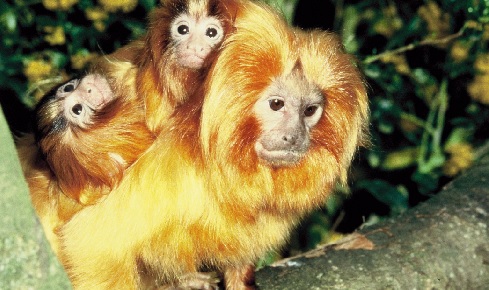 In the 2000s it was feared that the goldenheaded lion tamarin (Leontopithecus chrysomelas) would endanger local populations of L. rosalia
In the 2000s it was feared that the goldenheaded lion tamarin (Leontopithecus chrysomelas) would endanger local populations of L. rosalia
It was at this time that an appeal letter was again sent to ask all the previous holders of lion tamarins outside Brazil to contribute to ‘The Lion Tamarins of Brazil Fund’ (LTBF). By 2007 it was reported that the LTBF had raised in excess of US$1m in support of the conservation of the lion tamarin programmes in Brazil. This is also the first time that a group of zoos holding an endangered species in captivity, having returned the ownership of them to the species’ country of origin, has contributed annually to the species’ survival in its natural environment.
In the early 2000s it was revealed that a private collector had released a number of the Bahian golden-headed lion tamarins into a forest not far from Poço das Antas. As their numbers had increased rapidly there was considerable concern that L. chrysomelas would eventually hybridise with, or entirely replace, the nearby populations of L. rosalia. So in 2009 an NGO was created to help capture the introduced L. chrysomelas and return them to their native forest homes in the state of Bahia. As of 2020 almost 1,000 of these individuals had been trapped (from 175 social groups) – some remain in Rio de Janeiro and efforts continue to capture and remove them all[8].
Obstacles in the road
In 2014 an AMLD survey of the golden lion tamarins throughout their geographic distribution indicated a much larger population than had been expected: 3,706 individuals living in 41,411ha of forest, albeit not all connected and protected[9].
However, there was a new hazard for the lion tamarins: the doubling in width of an interstate toll road that passed right by the Poço das Antas reserve, isolating the reserve from lion tamarins living just outside its boundary. After seven years (2011–2018) of negotiations carried out by AMLD with the Rio de Janeiro state environmental and development agencies, a mandatory condition was established that a wildlife bridge must be included in the planning application. This important measure is the first of its kind in Brazil and has now become a model and precedent for wildlife protection measures in highway construction throughout the country[1].
In 2018 there was another major setback to the conservation programme when a yellow-fever epidemic that started in south-east Brazil reached the golden lion tamarins. It reduced the wild population of L. rosalia by 32% to an estimated 2,516 individuals. AMLD and partners have since developed a safe and effective vaccine to protect the lion tamarins[9]. Fortunately, there is now such a strong population of golden lion tamarins in Brazil and around the world “that they could once again be reintroduced if populations disappear or drop to critically low numbers in the wild”[1].
The AMLD and partners continues to assess mortality rates and to move L. rosalia from areas least affected by yellow fever to depleted populations hardest hit by the disease. They are also studying whether the tamarins are developing an immunity to yellow fever. The programme will continue to plant forest corridors to connect habitat fragments, and work with local landowners to assure the permanent protection of the forests remaining on their farms.
Future forests
The future conservation of the golden lion tamarins will mostly depend on whether populations suffer additional losses from yellow fever in the coming years. However, it has been established that populations of lion tamarins have the potential to grow 13–14% per year and can quickly repopulate areas of adequate habitat if the mortality rate is not high. The current number of golden lion tamarins in the wild is estimated at 2,616 individuals, which is considered just adequate to meet management goals.
However, with AMLD and partners having developed a safe and effective vaccine to protect the tamarins, should yellow fever persist in forests occupied by them the vaccine may make the difference between losing this endangered species, and keeping it from extinction[9].
This year, on the 50th anniversary of the Golden Lion Tamarin Conservation Programme, Dr Anthony Rylands, editor of the journal Primate Conservation, and Global Wildlife Conservation’s primate director, said the conservation of this species should be used as an example for other programmes around the world. “Over half a century the fight to save these remarkable monkeys has been at the forefront of the fight to save what are now the last remnants of Brazil’s Atlantic Forest, and the pioneering and innovative measures for these lion tamarins have been, and continue to be, exemplary for saving species in tropical forests worldwide.”
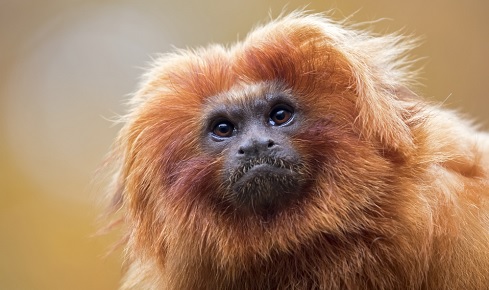 A golden lion tamarin (L. rosalia)
A golden lion tamarin (L. rosalia)Dr Russell Mittermeier, chair of the IUCN/SSC/Primate Specialist Group, and chief conservation officer for Global Wildlife Conservation, stressed the need for efforts to continue. “We’ve brought the golden lion tamarin back from the brink before and we know what needs to be done to save it, but we can never lose our focus. Conservation of endangered species like the golden lion tamarin requires a permanent sustained effort. And in spite of all the efforts on the golden lion tamarin’s behalf, and the attention that it has received, its future still hangs in the balance.”
When the COVID-19 pandemic is over and safe travel resumes, tourists will be able to visit the area once again and appreciate the beauty of the Atlantic Forest and the remarkable treasures to be found there, not least among them the golden lion tamarin[1].
Jeremy Mallinson OBE FRSB served on all four International Recovery and Management Committees for lion tamarins and co-chaired the committees for the golden-headed lion tamarin and the black-faced lion tamarin. In 2015 the Save the Golden Lion Tamarin Association appointed him as an ambassador for the lion tamarins of Brazil.
• Associaçäo Mico-Leäo-Dourado (AMLD) www.micoleao.org.br
• Save the Golden Lion Tamarin www.savetheliontamarin.org
• Lion Tamarin of Brazil Fund (LTBF) beh@zoo.dk or mst@zoo.dk
• Global Wildlife Conservation www.globalwildlife.org
1) Mittermeier, R. A. Reflections on the Golden Lion Tamarin (Global Wildlife Conservation, Washington, D.C, 2020).
2) Coimbra-Filho, A. F. & Mittermeier, R. A. Distribution and ecology of the genus Leontopithecus lesson, 1840 in Brazil. Primates 14(1), 47–66 (1973).
3) Rylands, A. B. et al. A history of lion tamarin conservation and research. In Lion Tamarins: Biology and Conservation, (eds Kleiman, D. G. & Rylands, A. B.) 3–41. (Smithsonian Institution Press, Washington, D.C., 2002).
4) Kleiman, D. G. & Mallinson, J. J. C. Recovery and Management Committees for Lion Tamarins: Partnerships in Conservation Planning and Implementation. Conserv. Biol. 12(1), 27–38 (1998).
5) Rambaldi, D. M. et al. The role of non-governmental organisations and the International Committee for the Conservation and Management of Leontopithecus in lion tamarin conservation. In Lion Tamarins: Biology and Conservation (eds Kleiman, D. G. & Rylands, A. B.) 71–95 (Smithsonian Institution Press, Washington, D. C.,2002).
6) Seal, U. S. et al. Leontopithecus population viability workshop report (Belo Horizonte, Brazil: IUCN/SSC Captive Breeding Specialist Group, 1990).
7) Kierulff, M. C. M. & Rylands, A. B. Census and distribution of the golden lion tamarin (Leontopithecus rosalia). Am. J. Primatol. 59(1), 29–44 (2003).
8) Kierulff, M. C. M, et al. The golden lion tamarin Leontopithecus rosalia: a conservation success story. Int. Zoo Yearb. 46(1), 36–45 (2012).
9) Dietz, J. M. et al. Yellow fever threatens the successful recovery of golden lion tamarins. In: Tamarin Tales: Newsletter of the Lion Tamarins of Brazil Fund 15, 1–5. (Copenhagen Zoo, Denmark, 2020).


